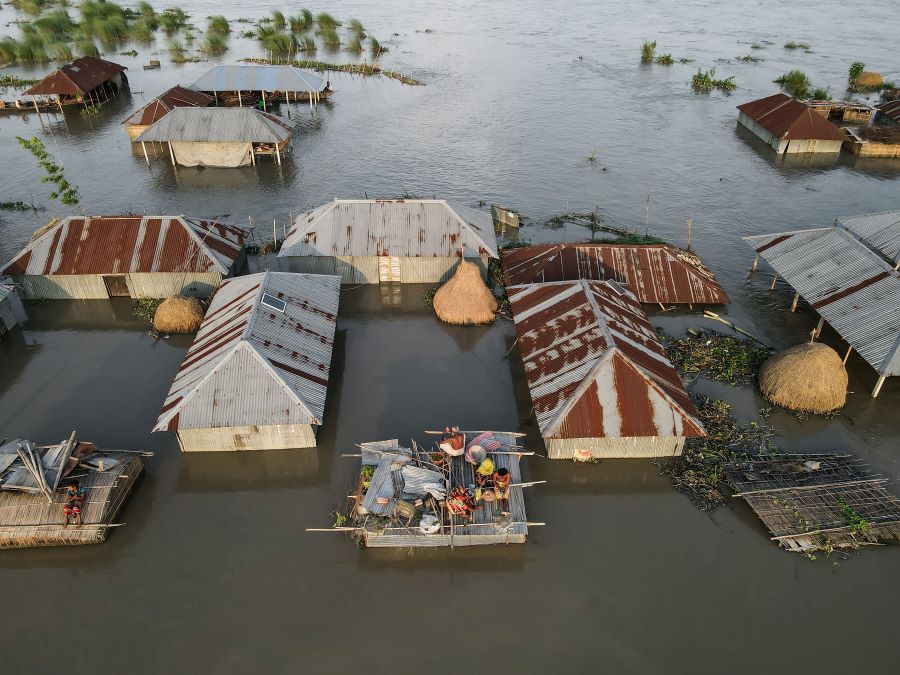Report on IUCN’s Investment in Nature-based Solutions for Sustainable Development
Strategic Alignment with Global Goals
The International Union for Conservation of Nature (IUCN) is actively accelerating financial investment in Nature-based Solutions (NbS) to address climate change, a critical action in support of the Sustainable Development Goals (SDGs). This initiative directly targets SDG 13 (Climate Action) by mobilizing capital for projects that utilize nature for climate adaptation and resilience. The approach also fosters collaboration and financial innovation, underpinning SDG 17 (Partnerships for the Goals).
Key Financial Mechanisms and SDG Linkages
IUCN employs several grant mechanisms to channel funding towards NbS, with a collective total of 200 million USD available. Each facility is designed to address specific environmental and developmental challenges, contributing to a range of SDGs:
- The Global EbA Fund: Focuses on Ecosystem-based Adaptation, directly supporting SDG 13 (Climate Action) and SDG 15 (Life on Land) by strengthening the resilience of ecosystems and communities.
- The Blue Natural Capital Financing Facility: Targets marine and coastal ecosystems, making a direct contribution to SDG 14 (Life Below Water) through the conservation and sustainable use of ocean resources.
- The Subnational Climate Finance Initiative: Empowers local and regional governments to implement climate action, aligning with SDG 11 (Sustainable Cities and Communities) and SDG 13.
- The Nature+ Accelerator Fund: Supports enterprises that restore and conserve nature, thereby promoting SDG 8 (Decent Work and Economic Growth) and SDG 15.
Economic and Social Impact Analysis
Economic research indicates a significant return on investment for climate adaptation and resilience projects. An average investment of one dollar is estimated to yield four dollars in benefits. This 1:4 impact ratio highlights the economic viability of NbS and its contribution to multiple development objectives. As noted by Mari Pangestu, Managing Director of Development Policy and Partnership at the World Bank, investing in nature yields multifaceted benefits that are central to the SDG framework:
- Job Creation: Investments stimulate local economies and create employment opportunities, advancing SDG 8 (Decent Work and Economic Growth).
- Poverty Reduction: By targeting the poorest communities, these initiatives contribute to SDG 1 (No Poverty).
- Long-term Resilience: Building environmental and community resilience is fundamental to achieving sustainability across all goals, particularly SDG 11 and SDG 13.
SDGs Addressed in the Article
- SDG 1: No Poverty – The article mentions that investing in nature can target the poorest communities and build their resilience.
- SDG 8: Decent Work and Economic Growth – It is stated that these investments can create jobs and contribute to economic recovery.
- SDG 13: Climate Action – The central theme is accelerating investment in Nature-based Solutions for climate change adaptation and resilience.
- SDG 14: Life Below Water – The mention of the “Blue Natural Capital Financing Facility” directly relates to marine and coastal ecosystems.
- SDG 15: Life on Land – The overall concept of Nature-based Solutions and initiatives like the “Global EbA Fund” (Ecosystem-based Adaptation) concern the conservation and restoration of terrestrial ecosystems.
- SDG 17: Partnerships for the Goals – The article highlights the mobilization of finance through multiple grant mechanisms and partnerships, such as the one between IUCN and the World Bank.
Specific SDG Targets Identified
-
SDG 1: No Poverty
- Target 1.5: By 2030, build the resilience of the poor and those in vulnerable situations and reduce their exposure and vulnerability to climate-related extreme events and other economic, social and environmental shocks and disasters.
Explanation: The article directly supports this target by stating that investing in nature helps in “targeting the poorest communities, and building long-term resilience” against climate change impacts.
- Target 1.5: By 2030, build the resilience of the poor and those in vulnerable situations and reduce their exposure and vulnerability to climate-related extreme events and other economic, social and environmental shocks and disasters.
-
SDG 8: Decent Work and Economic Growth
- Target 8.5: By 2030, achieve full and productive employment and decent work for all women and men, including for young people and persons with disabilities, and equal pay for work of equal value.
Explanation: The article connects investment in nature to economic recovery efforts by highlighting its potential for “creating jobs”.
- Target 8.5: By 2030, achieve full and productive employment and decent work for all women and men, including for young people and persons with disabilities, and equal pay for work of equal value.
-
SDG 13: Climate Action
- Target 13.1: Strengthen resilience and adaptive capacity to climate-related hazards and natural disasters in all countries.
Explanation: The article’s focus on “climate adaptation and resilience” through Nature-based Solutions is a direct contribution to this target. - Target 13.a: Implement the commitment undertaken by developed-country parties to the United Nations Framework Convention on Climate Change to a goal of mobilizing jointly $100 billion annually by 2020 from all sources to address the needs of developing countries…
Explanation: The article details the “acceleration of financing for nature-based solutions for climate change” through various funds that “collectively represent 200 million USD in available funding,” which aligns with the goal of mobilizing climate finance.
- Target 13.1: Strengthen resilience and adaptive capacity to climate-related hazards and natural disasters in all countries.
-
SDG 14: Life Below Water
- Target 14.2: By 2020, sustainably manage and protect marine and coastal ecosystems to avoid significant adverse impacts, including by strengthening their resilience…
Explanation: The specific mention of the “Blue Natural Capital Financing Facility” indicates that a portion of the investment is directed towards protecting and strengthening the resilience of marine and coastal ecosystems.
- Target 14.2: By 2020, sustainably manage and protect marine and coastal ecosystems to avoid significant adverse impacts, including by strengthening their resilience…
-
SDG 15: Life on Land
- Target 15.1: By 2020, ensure the conservation, restoration and sustainable use of terrestrial and inland freshwater ecosystems and their services…
Explanation: The initiatives described, such as the “Global EbA Fund,” are designed to finance Nature-based Solutions that inherently involve the conservation and restoration of terrestrial and freshwater ecosystems.
- Target 15.1: By 2020, ensure the conservation, restoration and sustainable use of terrestrial and inland freshwater ecosystems and their services…
-
SDG 17: Partnerships for the Goals
- Target 17.3: Mobilize additional financial resources for developing countries from multiple sources.
Explanation: The article describes how IUCN mobilizes finance through “multiple grant mechanisms,” including four distinct funds, which exemplifies mobilizing resources from various sources.
- Target 17.3: Mobilize additional financial resources for developing countries from multiple sources.
Indicators for Measuring Progress
-
SDG 13: Climate Action
- Indicator 13.a.1: Mobilized amount of United States dollars per year starting in 2020 accountable towards the $100 billion commitment.
Explanation: The article explicitly mentions a quantifiable amount of mobilized funds: “200 million USD in available funding for NbS.” This figure serves as a direct measure for this indicator.
- Indicator 13.a.1: Mobilized amount of United States dollars per year starting in 2020 accountable towards the $100 billion commitment.
-
Implied Indicators
- Economic Return on Investment: The article states that “an investment of 1 dollar in climate adaptation and resilience yields 4 dollars in benefits, on average.” This 1:4 impact ratio is a key performance indicator used to measure the economic efficiency and benefits of the investments.
- Number of Jobs Created: The claim that investing in nature can be measured by its contribution to “creating jobs” implies that the number of employment opportunities generated is a relevant indicator of success.
- Funds Disbursed to Poorest Communities: The goal of “targeting the poorest communities” implies that an indicator would be the amount or percentage of funding directed specifically to these vulnerable groups to measure progress in building their resilience.
Summary Table of SDGs, Targets, and Indicators
| SDGs | Targets | Indicators |
|---|---|---|
| SDG 1: No Poverty | 1.5: Build resilience of the poor to climate-related extreme events. | (Implied) Funds disbursed to poorest communities to build long-term resilience. |
| SDG 8: Decent Work and Economic Growth | 8.5: Achieve full and productive employment and decent work for all. | (Implied) Number of jobs created through investments in nature. |
| SDG 13: Climate Action | 13.1: Strengthen resilience and adaptive capacity to climate-related hazards. | (Implied) Economic return on investment (1:4 impact ratio mentioned). |
| 13.a: Mobilize financial resources to address the needs of developing countries. | 13.a.1: Mobilized amount of United States dollars per year (e.g., “200 million USD in available funding”). | |
| SDG 14: Life Below Water | 14.2: Sustainably manage and protect marine and coastal ecosystems. | (Implied) Amount of financing allocated through the “Blue Natural Capital Financing Facility.” |
| SDG 15: Life on Land | 15.1: Ensure the conservation, restoration and sustainable use of terrestrial and inland freshwater ecosystems. | (Implied) Amount of financing allocated through funds like the “Global EbA Fund.” |
| SDG 17: Partnerships for the Goals | 17.3: Mobilize additional financial resources for developing countries from multiple sources. | (Implied) Number and value of grant mechanisms and funds established (e.g., the four funds mentioned). |
Source: iucn.org







